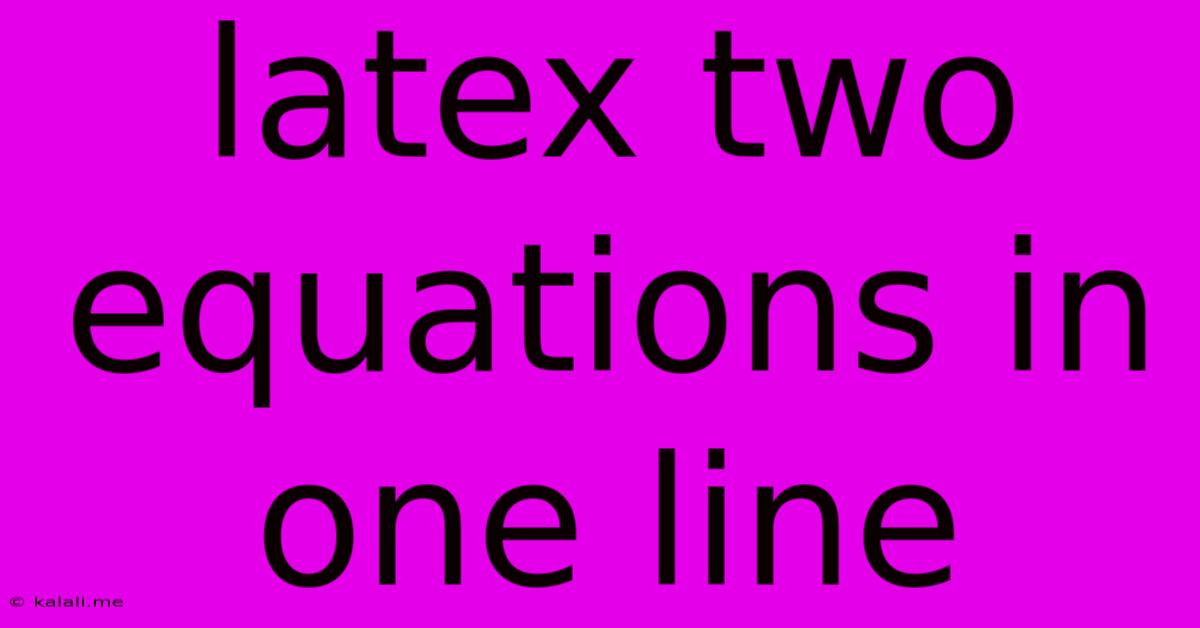Latex Two Equations In One Line
Kalali
May 23, 2025 · 3 min read

Table of Contents
How to Write Two Equations in One Line in LaTeX
Writing multiple equations on a single line in LaTeX is a common formatting need, particularly when presenting systems of equations or related expressions concisely. This guide will show you several methods, each with its advantages and best use cases. This will improve the visual appeal and readability of your mathematical documents, making them easier to understand and more professional looking.
Understanding the Fundamentals:
Before diving into the techniques, remember that LaTeX relies on specific commands to control the spacing and alignment of your mathematical expressions. Improper use can lead to equations that are cramped, uneven, or simply incorrect.
Method 1: Using & and align environment
The align environment is powerful for aligning equations, particularly useful when you have multiple equations with common elements. The & symbol indicates the alignment point.
\begin{align}
x + y &= 5 \\
x - y &= 1
\end{align}
This will produce two equations, each aligned at the equals sign. This is ideal for systems of equations where aligning the equals signs enhances readability. You can easily extend this to more equations.
Method 2: Using & and equation environment with \qquad
For less formal situations where you want two unrelated equations on one line, you can use the equation environment combined with \qquad (a large space command).
\begin{equation}
E = mc^2 \qquad F = ma
\end{equation}
This places two equations side-by-side with significant spacing between them. The amount of space can be adjusted by using other spacing commands like \,, \;, \quad, or even multiple \qquad for more separation. Remember to choose an amount of spacing that's visually appealing and enhances readability, not detracts from it.
Method 3: Using gather Environment for Unaligned Equations
If alignment isn't critical, the gather environment offers a simple way to place multiple equations on a single line without specific alignment points.
\begin{gather}
a^2 + b^2 = c^2 \\
\int_0^1 x^2 dx = \frac{1}{3}
\end{gather}
This method provides vertical spacing between the equations, ensuring they are clearly separated, even without specific alignment. This is beneficial for showing a series of unrelated formulas or equations.
Choosing the Right Method:
The best method depends on your specific needs:
align: Ideal for systems of equations or multiple equations that share a common alignment point (e.g., the equals sign).equationwith\qquad: Suitable for placing two relatively independent equations on the same line, requiring a clear visual separation.gather: Best for a collection of unrelated equations where precise alignment is not necessary.
Advanced Techniques:
For even more control, explore other LaTeX environments like aligned (within other environments like equation) for fine-grained alignment within a larger equation structure. This allows for complex layouts where you have multiple equations intertwined or nested within each other.
By mastering these techniques, you can create clear, concise, and visually appealing mathematical documents in LaTeX. Remember to always prioritize readability and choose the method best suited for your specific mathematical expressions. Experiment with different spacing commands to find the best visual presentation for your work.
Latest Posts
Latest Posts
-
How Many Inches Is A Meter Stick
Jul 10, 2025
-
Soundtrack To Step Up 2 The Streets
Jul 10, 2025
-
Keebler Club And Cheddar Crackers Expiration Date
Jul 10, 2025
-
In Many States Trailers With A Gvwr Of 1500
Jul 10, 2025
-
How Many Tablespoons Are In A Hidden Valley Ranch Packet
Jul 10, 2025
Related Post
Thank you for visiting our website which covers about Latex Two Equations In One Line . We hope the information provided has been useful to you. Feel free to contact us if you have any questions or need further assistance. See you next time and don't miss to bookmark.